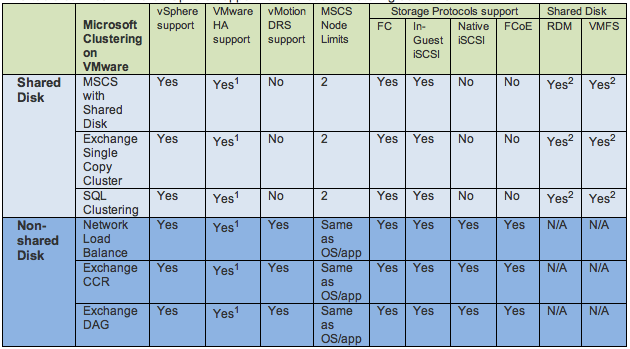VMware vSphere and Microsoft Clustering
I have been investigating some things that need to be considered when deploying a Microsoft Cluster on a VMware platform.
As you can see on the graph, there are some different supported configurations. The kb 1037959 shows more information, i will try to highlight some things below.

Why i started this was because i was looking at the Multipathing polices for a customer and we discussed in the office that we preferred the Round-Robin policy, This is as you also can read on the KB not supported for the RDM shared disk, so if you already have Round Robin as default on your hosts you have to set another policy on that specific LUN.
This can be done by powerCLI or by the vClient GUI, and as i am a big fan of powerCLI i will show you the command for it
VMHost hostname.test.local | Get-ScsiLun -CanonicalName "naa.60054242555" | ' Set-ScsiLun -MultipathPolicy "fixed"
If your default multipathing policy is set to one you do not want you can edit the default both with VMware CLI and powerCLI, as for the last there is a script that Stephen has made and can be found on the VMware Communities forum. otherwise you will have to change policy on every new datastore you add manually.
If you have a iSCSI SAN you will use in-guest iSCSI connection to the shared storage, then there is no need to change multipathing polices, what i do not understand and have not got any good information about is when i use in-guest shared storage, why do VMware have a limit of two cluster nodes that they support? As I see it the limit should be what MSCS has as a limit and that is 16 nodes, maybe there is no need for such a big cluster as you already have HA in your virtualization platform. If the setup as you can se in the graph is a cluster without shared storage it is not any limits set on number of nodes.
You will also need to edit your VMs scsi controller, for the Win 2008 you must have the LSI SAS controller installed, there is a KB 1002149 for that where the steps are outlined. The shared disk must reside on a dedicated scsi controller.
You will also have to setup Anti-Affinity rules in DRS to keep your cluster nodes apart, if you have for some reason decided to setup a CIB (Cluster in a Box) then you will need to setup an affinity to keep them together on the same host. For the VMs that are used for clustering you should set the DRS to partially automated.
For more information how to setup look at the VMware documentation on setup of failover clusters pdf